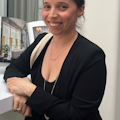Pratt's Master of Industrial Design Thesis Presentations
There is no better place to get a clear picture of the future than to attend the thesis presentations at any A&D-focused school. I&S has been honored to sit for these every spring at a number of colleges and institutes, but this year we decided to turn our spotlight on Pratt’s Master of Industrial Design program.
These grad students are welcomed from a variety of backgrounds and bachelor’s degrees such as social sciences and engineering, as well as the traditional fields of architecture and interior design, and it definitely shows in the originality of their presentations. This year’s took place at Pratt’s Brooklyn Fashion + Design Accelerator (BF+DA). Talk about cutting-edge—this space is an incubator for groundbreaking new startups and currently houses 24 fledgling product, apparel, and technology businesses.
Over the course of two days, M.I.D. candidates presented their thesis work under the umbrella theme of “Fake ID,” which represented this shift in the field to include other disciplines. Each chose a movement that was important to them and presented their ideas on products and designs that would make gains in its development and improvement. On these pages are three that we felt address two vital topics coming down the pipeline: interactive design—where inhabitants can engage with the physical space—and on the flip side, using design to reprioritize face-to-face interaction
winnie wen: living luggage
Everybody hates to travel. But maybe soon it won’t be so tedious if Winne Wen gets her way. Her “Living Luggage” concept is another exploration into interactive design. “There is little emotional connection between users and the objects. I intend to go beyond that one-way interaction,” she explained. By using a suitcase as an example, she illustrates how when products respond to human touch in unexpected ways, it can foster an emotional relationship. Her living luggage not only serves its common duty of transporting items but engages its owner in ways that reduce stress throughout their journeys…such as no more lugging behind you!
Advisor: Katrin Mueller-Russo
For more information: winniewendesign.com
selen sariel: static distraction xmobile communication
Sariel knows the importance of technology. But she also acknowledges what we’re losing with these advancements when applied to our products and interiors: human interaction. Inspired by the Apple Watch, her thesis “Static Distraction x Mobile Communication” explores a way to maintain how far we’ve come, while getting back to our roots of eye contact and human touch.
The wearable communication device she ended up with achieves that balance as it can transform from wearable to handheld and back again, giving users the opportunity to determine their level of attachment. It connects to smart kiosks throughout the city where users can perform more static functions such as watching a video or writing an email.
Advisor: Sinclair Smith, Bruce Hannah
For more information: [email protected]
sebastian jacobo: sensible geometry
Jacobo’s thesis “Sensible Geometry” was a great illustration of what smart interiors might look like in the next few years. By integrating elements like the living wall he presented—which relies on the movement of inhabitants and the ebb and flow of a crowd—spaces will be taken to the next level with design that we can actually engage with. Infrared sensors embedded within this three-dimensional wall sculpture allow it to respond to the amount and speed of passersby and move in time with them.
But more than that, “Sensible Geometry” explores how information can be represented beyond a two-dimensional form. By transforming into sensitive objects, it becomes more perceivable. Jacobo’s message is about integrating technology, information, and design to understand the world around us without creating useless amounts of data, but rather forms that relay a message and disappear when they are no longer needed.
Advisor: Ignacio Urbina Polo
For more information: sebastianjacobo.com
About the Author
AnnMarie Martin
Editor-in-Chief
AnnMarie is the former Editor in Chief of i+s and has been covering the commercial design space. Her style and vision has helped the brand evolve into a thought leader in purpose-driven design and cultural movements shaping the way we live and work.

